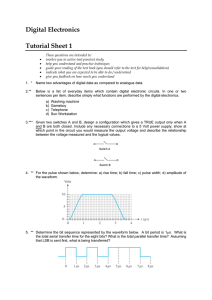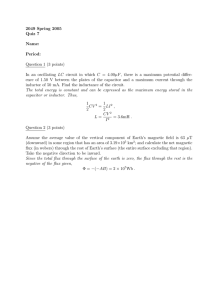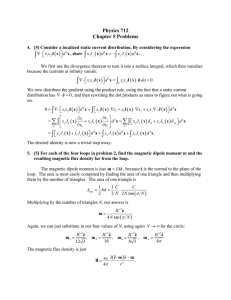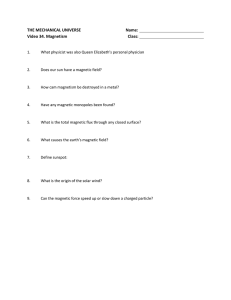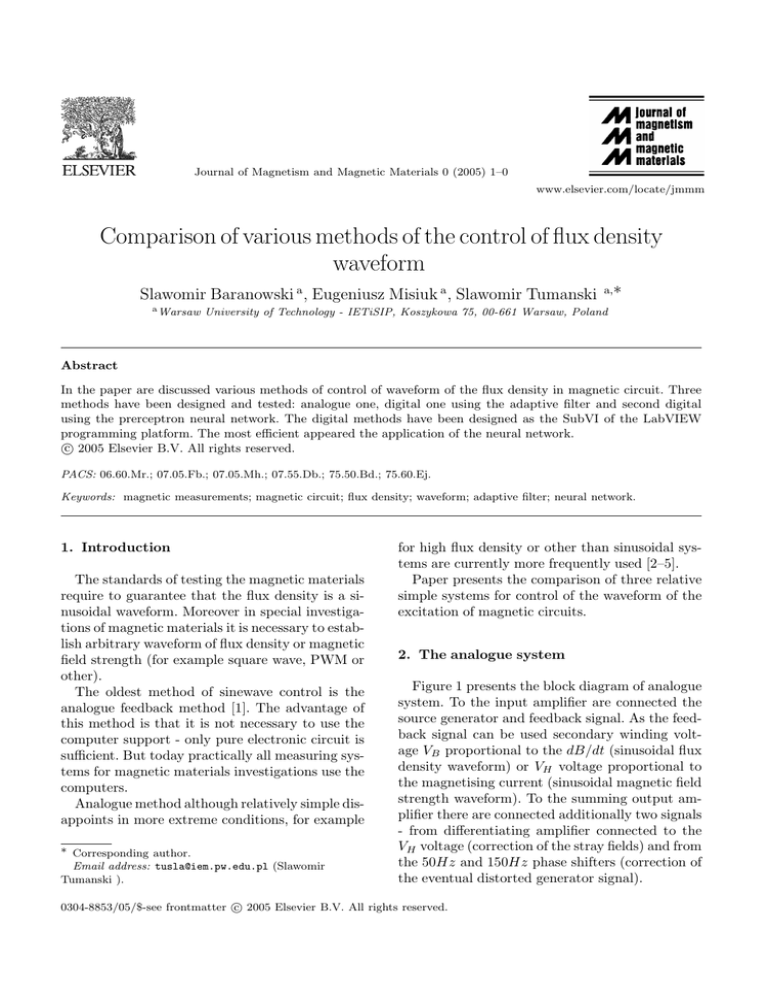
Journal of Magnetism and Magnetic Materials 0 (2005) 1–0
www.elsevier.com/locate/jmmm
Comparison of various methods of the control of flux density
waveform
Slawomir Baranowski a , Eugeniusz Misiuk a , Slawomir Tumanski a,∗
a Warsaw
University of Technology - IETiSIP, Koszykowa 75, 00-661 Warsaw, Poland
Abstract
In the paper are discussed various methods of control of waveform of the flux density in magnetic circuit. Three
methods have been designed and tested: analogue one, digital one using the adaptive filter and second digital
using the prerceptron neural network. The digital methods have been designed as the SubVI of the LabVIEW
programming platform. The most efficient appeared the application of the neural network.
c 2005 Elsevier B.V. All rights reserved.
°
PACS: 06.60.Mr.; 07.05.Fb.; 07.05.Mh.; 07.55.Db.; 75.50.Bd.; 75.60.Ej.
Keywords: magnetic measurements; magnetic circuit; flux density; waveform; adaptive filter; neural network.
1. Introduction
The standards of testing the magnetic materials
require to guarantee that the flux density is a sinusoidal waveform. Moreover in special investigations of magnetic materials it is necessary to establish arbitrary waveform of flux density or magnetic
field strength (for example square wave, PWM or
other).
The oldest method of sinewave control is the
analogue feedback method [1]. The advantage of
this method is that it is not necessary to use the
computer support - only pure electronic circuit is
sufficient. But today practically all measuring systems for magnetic materials investigations use the
computers.
Analogue method although relatively simple disappoints in more extreme conditions, for example
∗ Corresponding author.
Email address: tusla@iem.pw.edu.pl (Slawomir
Tumanski ).
for high flux density or other than sinusoidal systems are currently more frequently used [2–5].
Paper presents the comparison of three relative
simple systems for control of the waveform of the
excitation of magnetic circuits.
2. The analogue system
Figure 1 presents the block diagram of analogue
system. To the input amplifier are connected the
source generator and feedback signal. As the feedback signal can be used secondary winding voltage VB proportional to the dB/dt (sinusoidal flux
density waveform) or VH voltage proportional to
the magnetising current (sinusoidal magnetic field
strength waveform). To the summing output amplifier there are connected additionally two signals
- from differentiating amplifier connected to the
VH voltage (correction of the stray fields) and from
the 50Hz and 150Hz phase shifters (correction of
the eventual distorted generator signal).
c 2005 Elsevier B.V. All rights reserved.
0304-8853/05/$-see frontmatter °
Slawomir Baranowski et al. / Journal of Magnetism and Magnetic Materials 0 (2005) 1–0
Two cases have been tested: with the source generator and with the power net used as the source.
The results are presented in Table 1.
Table 1
Distortion of the dB/dt signal and B signal when as the
source the power net was used (a) and when as the source
signal generator was used (b)
Tested signal
Case
THD [%]
power net
0.4
a) dB/dt
without feedback
22
a) dB/dt
with feedback
3.6
a) B
without feedback
6.4
a) B
with feedback
1.0
a) input signal
b) input signal signal generator
without feedback
22
b) dB/dt
with feedback
5.3
without feedback
7.4
b) B
of LabVIEW programme). The fixed value (and
shape) source signal via filter coefficients units hn
(individual for every sample), DAC unit and power
amplifier is connected to primary winding. The secondary voltage via ADC unit is compared (sample
by sample) with reference signal. The difference is
used to change the filter coefficients hn according
to the LMS (least mean square) method.
X
x1
x2
xN
bref1
Bref
bref2
brefN
Adaptive
Filter
h1
h2
hN
z1
z2
zN
3.6
b) dB/dt
b) B
2
with feedback
1.4
Even when as the source generator was used distorted power net (case a) the flux density waveform
was perfectly sinusoidal.
IN
Y
y1
y2
yN
B
b1
b2
bN
ADC & Integration & Shift
DAC & PA
ug
ub
Fig. 2. The magnetic circuit with the adaptive filter used
to control the waveform
4. The neural network system
PA
PS
dH
dt
VB
VH
dB/dt
Fig. 1. The magnetic circuit with the neural network used
to control the waveform
3. The adaptive filter system
The system with adaptive filter is presented in
Fig. 2. The system consist of computer with data
acquisition board (including digital to analogue
DAC converter and analogue to digital ADC converter) and power amplifier PA. As the source generator is used virtual sine wave generator (subVI
The system with neural perceptron network
(Fig. 3) works similarly to described earlier adaptive filter. A virtual source signal is converted by
two-layer perceptron net with input number equal
to number of samples.
The weights of perceptron layers are initialised
randomly. Next from the difference between reference and output voltage the weight coefficients
of the last layers are computed. Next according to
the principle back propagation of errors the weight
of the next layers are determined. The adaptation
of the weights is realised according to the relation w(k + 1) = w(k) + 4w, where w(k) are the
weights in the k-step and 4w = −µ∇E(w). The
µ coefficient is the learning rate while objective
function E(w) is
E(w) =
1
2
P
(bk − bref k )2
Slawomir Baranowski et al. / Journal of Magnetism and Magnetic Materials 0 (2005) 1–0
X
x1
x2
xN
bref1
bref2
brefN
Neural
Network
w11 (1) w (1)
12
w1N (1)
v1
Bref
v2
z1
vN
z2
zN
w1N (2)
y1
and without waveform correction. Table 2 presents
the results of iteration determined for grain oriented steel and assumed flux density value equal
to 1.8 T (the algorithm started from zero value).
Table 2
The iteration process of algorithm
w11 (2) w12 (2)
Y
3
y2
DAC & PA
ug
yN
B
b1
b2
bN
ADC & Integration & Shift
ub
Fig. 3. The magnetic circuit with the neural network used
to control the waveform
Number of Bmax k = Urms /Uavg THD
iteration
[T]
[-]
[%]
1
0.018
-
-
5
1.08
1.10248
4.3
10
1.72
1.09828
7.8
15
1.76
1.07466
24.5
18
1.80
1.11079
1.0
The speed of the algorithm can be significantly
improved by learning the net to establish initially
the weight coefficients to expected values (similarly
is it proposed Matsubara [5]) or by appropriate
change of the learning coefficient µ.
5. Conclusion
The analogue system depends on the quality of
source generator and power amplifier. In extreme
cases (high value of the flux density) such system
can operate not correctly.
From the comparison of both digital systems the
system utilising the neural network seems to be
better. For example to obtain the same result the
neural network based system required 24 steps of
iteration while the system with adaptive filter required more than hundred steps.
References
Fig. 4. The output signal of the neural network Ugen and
the flux density signal B before (up) and after (down)
waveform correction
Fig. 4 presents the output signal of the neural
network Ugen and the flux density signal B with
[1] M.G. Blundell, K.J. Overshott, C.D. Graham,
J.Magn.Magn.Mat. 19 (1980) 243-244
[2] M. de Wulf, L.R. Dupre, J. Melkebeek, J. de Physique
8 (1998) 705-708
[3] N. Chatziilias, T. Meydan, C. Porter, J.Magn.Magn.
Mat. 254-255 (2003) 104-107
[4] S. Zurek, P. Marketos, T. Meydan, Przeglad
Elektrotechniczny 80 (2004) 122-125
[5] K. Matsubara, N. Takahashi, K. Fujiwara, T. Nakata,
M. Nakano, H. Aoki, IEEE Tr. Magn. 31 (1995) 34003402

